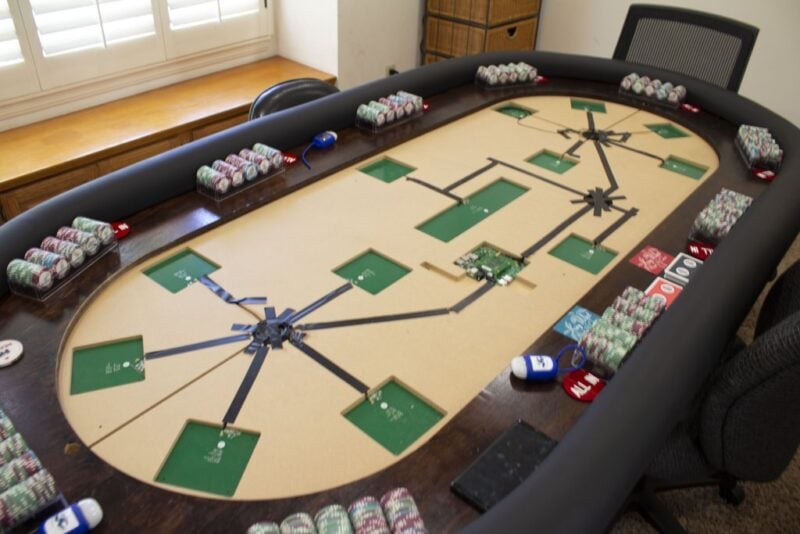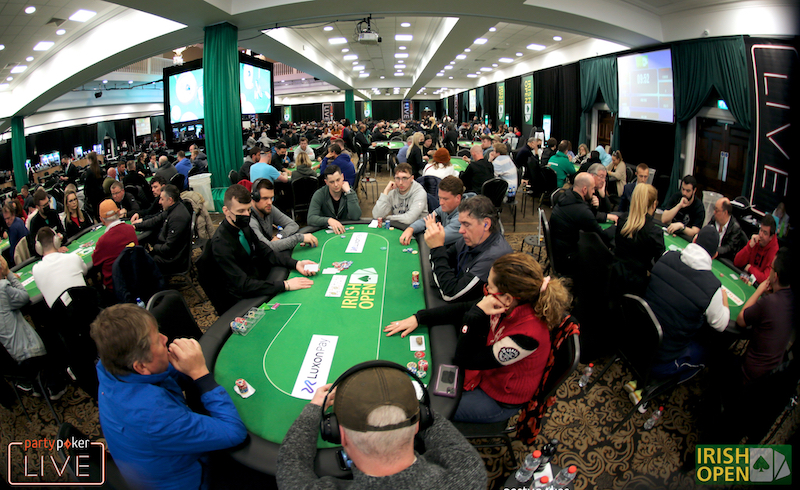I know, I know — I’m tired of reading a thousand different takes on whether Robbi Jade Lew cheated. If you want to know more about the story there is an excellent introduction to it here, but I for one, am tired of hearing opinions on Twitter from “experts” who are sure one way or the other.
For the record, I think it is fairly unlikely that she was cheating, but the more interesting discussion here is about how to deal with security in live poker broadcasts and how cheating could happen.

I first encountered RFID tables when I was the ambassador for the Mid-Stakes Poker Tour (MSPT) many years ago. The MSPT had one of the first RFID tables in America and it came with us to every tour stop. I didn’t love carrying it into casinos piece by piece and setting it up — the base is quite heavy — but the broadcasts were a big draw and it was worth it.
An introduction to RFID
Let’s start by answering the question at the heart of this article: is it possible to cheat using an RFID poker table?
Technically? Maybe. Realistically? I wouldn’t bank on it.
To understand why, you first have to know how the table works, so let’s start with a quick look at RFID technology.
RFID stands for Radio Frequency Identification. An RFID “tag,” basically a very small computer chip, is embedded within each card, which means that the decks cost more than $100 each. The decks are primarily used for poker broadcasts, though magicians sometimes use them as well (hope I didn’t ruin any tricks for you there).
An RFID reader sends radio waves at a certain frequency, known as interrogating waves, which cause the RFID chip to emit an electromagnetic signal. This signal is in the form of a number, which can be any number you like, from the numbers one through 52 for a deck of cards, to complex bar codes in factory settings. The reader catches this signal and interprets it for use by a computer.
In an RFID table, the readers are less than an inch below the area where the cards are placed by the players. There are wires that run under the table surface to a central computer in the middle of the table that puts the data together and sends it out to be used by the broadcast team.
So the information, things like the fact that seat 7 has the ace and the queen of clubs, is sent out via hardwire to whatever computer the broadcast team is using. From there, security is on them, but we’ll cover that in a bit.
I did a lot of research and some creative thinking when I was working with the MSPT, as well as on some broadcasts for other tours I’ve worked with. That left me with quite a bit of confidence in the answers to the most common questions, which seems like a good place to start.
Can someone just read the cards from across the room with their own RFID reader?
The tags used in RFID playing cards are passive, meaning they have no power of their own. They emit a very weak signal that’s powered by the radio waves from the reader. Some active RFID tags that are battery-powered can be read from a few hundred yards, but passive tags are much tougher to read from a distance.
The limit for these passive tags, even with a very strong reader, is about three feet. In experiments I did with a few RFID tables, the reader in the table can’t pick up a signal reliably from more than a few inches away. Reading them from three feet away is really really tough, and most experts agree that reading them from six feet away without serious military tech is basically impossible.
So the short answer is no, you can’t just buy an RFID reader and point it at the cards like a radar gun and know what everyone has. It’s an incredibly weak signal and, until I see proof that someone has figured out how to pick it up from a distance, I won’t believe it can be done. At least not in an environment where a huge and powerful machine would be easily spotted.
The chip in most credit cards these days is a form of RFID tag, and while lots of Facebook ads might try to sell you special wallets that protect your credit cards from RFID readers, this is clearly a tough thing to do or criminals would have already stolen all of our credit cards. I walk around with credit cards in my pocket every day and have never had this problem, though I’m sure it has been done to someone, somewhere.
So while the information is there, I don’t think the RFID chip being read by someone who isn’t supposed to read it is a likely weak point for poker cheats.
Can the computer in the poker table be hacked?
Well, yes, any computer system can be compromised. But the security here is physical, not digital. This is why the NSA has hard drives that are removable and not connected to the internet in some of their most secure computers. Because you have to physically be there to hack them and get the information out.
The computer in the table — at least in the tables I’ve worked with — doesn’t have a wifi connection. Broadcasting the information through the air would be a huge security hole, and anyone doing this is just begging to be hacked. Instead, the information resides in the computer until it goes out through an ethernet cable or fiber optic line.
If the computer was hacked, what could it do? It doesn’t have the ability to broadcast information, because it doesn’t have any wireless capabilities. This is an unlikely source of cheating, though it is theoretically possible that the computer could be compromised in some creative way to help get the information out.
Could a wireless transmitter be hidden in the table or the computer?
This could certainly be done, but it would require access to the table, and the broadcast and security folks would have to miss it. I have a USB device that creates a wifi connection that’s about the size of a nickel, and if the computer in the table were compromised, and a device like this was installed, the information could be stolen.
This would require not only access to the table and compromising the security of the computer, but would also require that no one noticed this new device. I know that the guy who ran the RFID table for us at the MSPT would have noticed this immediately. Something hardwired inside the computer box itself might have gone unnoticed for longer.
I don’t know of any reports of this actually happening, so it’s not a likely source of cheating at the moment, but it is certainly plausible.

Could the information be stolen from the wires?
This is an interesting question. It’s tough to “sense” information from a USB cable. A standard electric wire is easy, but a USB cable is tougher. For standard hacks, like connecting right into the cable or the LAN and getting the information, someone should notice very quickly. This would definitely not have worked with any set-up that I was part of because the cables were always in view.
But it is possible. And there are other interesting ways hackers could do this. A few example cases have even shown where a clever hacker could use the computer to turn the wire into a sort of wireless antenna that would transmit data. This would be one way to get past the “air gap” that security professionals recommend for very sensitive data that shouldn’t travel through the air.
Is this happening to RFID poker tables? Probably not. It might not even work in the environment of a poker room, and would require that the computer be compromised in a way that no one would notice, which would be a challenge for even the best hacker.
Other ways around the ‘air gap’
There have been proof of concept demonstrations of a few very creative ways around an air gap. Reading the noise of the computer’s fan has been used to determine passwords or encryption codes, but it takes time, isn’t reliable, and would be almost impossible to do with a poker table.
It’s also widely known among computer security researchers that electronic devices produce Ven Eck radiation, which is the sum of whatever information comes from a device, that can be read from a distance. Computer monitors are particularly susceptible to this, but almost any device could potentially reveal what it’s doing in this way.
Is someone using Van Eck radiation to read what’s inside the computers in the broadcast booth or the computer inside the table? It’s possible, more likely than a few of the other possibilities, but still probably not.
Can the information be stolen from the computer in the booth?
Now we’re getting somewhere. As the information spreads out to more places, it becomes more vulnerable to theft. And a PC or Mac is a much more complex device with many more security holes. A competent hacker with access to these machines could easily get them to send the data to other places.
That hacker would need access and skills, and risk serious jail time, in order to help someone cheat at poker. Reasonable security precautions would make this much tougher, but I haven’t been able to get much information about the security involved in the “Hustler Casino Live” broadcast booth.
What about the people who have access to this information?
This is by far the most likely security problem. It requires much less sophistication, and the temptation is right in front of anyone who has access to the information. This was likely the source of the Mike Postle cheating scandal, though Stones Gambling Hall has never released any official information that proves anything one way or another, and Postle still denies the allegations.
For a livestream to run without a significant delay, the commentators must have access to the cards in real-time, or very close to it. This means that security is now up in the air and depends entirely on the integrity of the people who have access to that information. If they want to get the information out, there are myriad ways they can do it.
How would the information get to the player who needed it?
This is another interesting question. There’s been a ton of speculation on this, from a vibrating hat in the case of Mike Postle, to vibrating sex toys and signals flashed from across the room. This is by far the easiest past of the equation for a cheat to solve. Recently, there’s been a significant scandal in the world of chess that’s led to speculation about a vibrating sex toy. The greatest chess player of our generation, Magnus Carlsen, walked away from a match with the alleged cheat and believes strongly that a device of some kind is being used.
Hand signals are simple, and a combination of both complex and subtle signals would be very hard to catch. Luckily, most cheats aren’t very careful by their very nature. If they were smart and careful, they would make money some other way that is both easier and less risky.
So how would I cheat on a livestream?
I would get a very sharp hacker to break into the machines used in the booth and get them to broadcast the information in a way that I could pick it up from a distance over the internet. I certainly wouldn’t want to be in the room. That makes it too easy to catch me, and also requires me to shield my phone from prying eyes while I watch the action and then send signals to the player.
It would be easier, and less risky, to do all that at home. They can’t throw you in jail if they can’t prove you did it, and that proof would be much harder to get if you aren’t in the room when it happens.
Then I would sew a small vibrating tag into the hem of the jeans of the player I was conspiring with. If done well, this would be very tough to detect. Putting it in the heel of a shoe would also work well.
The real key would be how the information was used. You would want a fairly skilled player and also a smart person sending the information. Sending a signal to call in a spot like the jack-four hand with Robbie Jade Lew would be a terrible move.
With a reasonable player who isn’t losing too much, even in a tough field, and can play a bit unpredictably to make sure their odd behaviors aren’t obvious, it’s within reason that a cheating team could make a significant amount of money before they were detected. It’s also possible that they could be caught quickly, have the money confiscated, and go to jail.
Unfortunately, most casinos don’t press charges in incidents like this. If you cheat the house, you go to jail. If you cheat other players, they ask you nicely not to do that again and send you on your way because they don’t want to deal with a scandal.
How I would really make money on the ‘Hustler Casino Live’ stream
Of course, I wouldn’t cheat, not even if I knew I could get away with it. It’s just not in my nature. The integrity of the game is important to me. And the truth is, there’s a ton of money to be made in these games without cheating. If a player studies the game and doesn’t get flustered by the big stage, I think making a million legitimately is much easier than cheating.
As of September 30, The top 20 cumulative winners on the stream have all made more than $200K, and the top two have made over a million. These games are often very soft given how big they are, and a studied player should be a nice favorite in most lineups.
We can’t all be Garrett Adelstein and make $1.5M by being a world-class crusher, but solid smart play, knowing combos and ranges, working with a solver for a few months, and having the bankroll to handle the swings, should generate an absurd hourly rate.
That’s why invites to this game are so sought after. And that’s the tough part. Buy Nick Vertucci a fancy cigar, get a big social media following, look interesting, and start some controversy, and you might get an invite yourself.


